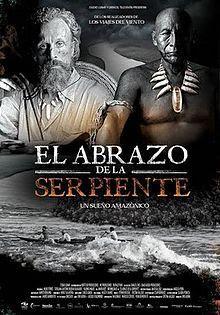
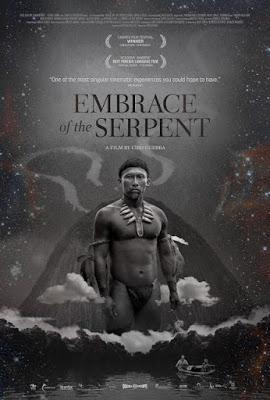
Both posters above are predominantly in black and white,
while color is utilized sparingly and effectively,
as in the film
“The display I witnessed in those enchanted hours was such that I find it impossible to describe in a language that allows others to understand its beauty and splendour; all I know is that, like all those who have shed the thick veil that blinded them, when I came back to my senses, I had become another man.” ---German scientist and explorer Theodor Koch-Grunberg’s (1872-1924) writings, quoted at the opening of the film
The year 2015 witnessed the release of three outstanding films from South American countries: Land and Shade from Colombia, The Pearl Button from Chile, and Embrace of the Serpent a co-production from Colombia, Argentina and Venezuela. Each of the three films deals with history and economics. Each film present a combination of fact and fiction, the last two blending history with actors playing fictional roles that have some facts to rely on. Each of the films provide the viewer an unsettling perspective of reality that you rarely encounter in cinema these days. Each of these three is an artistic work that will satisfy a sensitive viewer who is looking for entertainment without sex, violence, and escapist action. All three films are bolstered by outstanding cinematography, direction, and incredibly mature performances by little known actors that can make big Hollywood names pale in comparison. And more importantly, these films have been made for a fraction of the cost of an average Hollywood film.
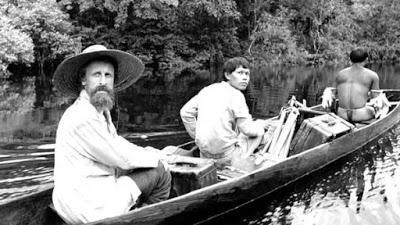
First journey: Koch-Grunberg (Bijvoet), Manduca, and young Karamakate,
with material possessions, including a phonograph
Embrace of the Serpent is a tale of two scientists/explorers: the German Theodor Koch-Grunberg (1872-1924) (played by Jan Bijvoet of Borgman) and the American Richard Evan Schultes (1915-2001) (played by Brionne Davis of Avenged). Both men were seeking a medicinal flower “yakruna” from a native shaman Karamakate (played by Nibio Torres, when young, and Antonio Bolivar, when old), who lives on the banks of the Amazon and its tributaries.
There is a 20-30 year gap (1909 to 1940) between the two encounters of Karamakate and the two explorers from the developed world. Koch-Grunberg was an ethnographer who had fallen ill while studying the Pemon natives of Venezuela and is brought to the shaman Karamakate, who knows about yakruna and where it can be found. This flower Koch-Grunberg had been told could cure the sick explorer. Karamakate distrusts Koch-Grunberg and Manduca, Koch-Grunberg’s native companion and recently freed slave. Karamakate refuses money as he takes the German and Manduca to Colombia along the Amazon only to find Colombian soldiers misusing the plant as an hallucinatory drug and growing it in untraditional ways for profit and drug abuse. The drugged soldiers and the plants are destroyed by the enraged young Karamakate. Koch-Grunberg is thus not cured and dies even though he is sustained for a while by Karamakate blowing a hallucinogenic powder up his nostril. However, Koch-Grunberg’s detailed notes of his trip with young Karamakate and the yakruna that he saw before the plants were destroyed, survive his passing.
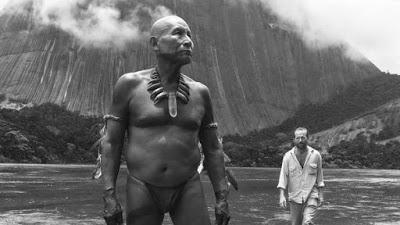
Second journey: American Richrd Evan Schultes (Davis) and the older
Karamakate (Bolivar), reach where the last yakruna grows
Decades later, the American scientist Richard Evan Schultes, having read the detailed notes of Koch-Grunberg, locates Karamakate, now much older and possibly with memory fading (or at least affecting to fade) and less temperamental than in his youth. The American is also searching for yakruna for commercial reasons because the genetic resource of the flower’s seeds can apparently make rubber trees disease-free adding to the profits of the global rubber industry chain, from forests to factory. Old crafty Karmakate shows him the last yakruna flower and cleverly cooks it for Schultes. The outcome shown in Embrace of the Serpent is, to say the least, fascinating.
What is the serpent in the title of the film? It is the Amazon. The Amazon does look like an anaconda when viewed from the sky. It appears as a massive snake that populates the Amazon banks and the director cleverly shows the birth of young anacondas early in the film. To add to the visual suggestion, there is a clever line in the script that states the natives believe the snake came from the skies. (This is not far removed from similar analogies within the traditional beliefs of natives of Chile in The Pearl Button.)
Two aspects of this important film stand out for any viewer. The two native actors who play Karamakate overshadow the performances of professional western actors in this film. The credit not only goes to the native actors but to the script of director and co-scriptwriter Ciro Guerra, co-scriptwriter Jacques Toulemonde Vidal and the cinematographer David Gallego. One has to admit considerable fiction has been enmeshed with the two historical trips on the Amazon river separated in time by some three decades.
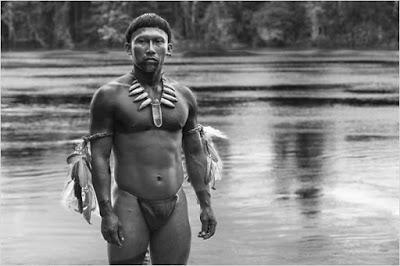
The young impetuous Karamakate (Torres) with the Amazon behind him
The second aspect of the film is the deliberate choice of the director Ciro Guerra to make Embrace of the Serpent in black and white (cinematographer David Gallego) for most parts. [This deliberate choice need to be compared with a few other important films on evil/distrust and reconciliation deliberately made in black and white with superb outcomes: Mike Nichol’s Who’s Afraid of Virginia Woolf? (1966), Jim Jarmusch’s Dead Man (1995) and Michael Haneke’s The White Ribbon (2009)—all cinematic works with reflective depth and common concerns which would have had lesser impact were they made in lush color.] It is possible that a color version of the film Embrace of the Serpent would have emphasized the wrong elements of the tale—the formidable river and the overarching rain forests. The pivotal aspect of the film is the traditional world of the natives and their knowledge of traditional medicine orally handed over generations and kept protected from commercial misuse. When color is used briefly by the filmmakers in Embrace of the Serpent, it is to communicate this wisdom. It is not surprising that several reviewers have noticed the parallels between Stanley Kubrick’s 2001: A Space Odyssey and Embrace of the Serpent. Science/scientific knowledge (here, specifically the commercial production of rare plants and genetic resources) and accumulated human wisdom are weighed against each other in both the cinematic works. Somewhere in the film Karamakate says, “Every tree, every flower brings wisdom.” The endings of both films, their release separated by half a century, will humble a reflective viewer.
Embrace of the Serpent provides much food for thought. The journeys on the river have parallels with Homer’s tale of Ulysses voyage. In Ciro Guerra’s film, there are three major ports/stops during the river voyage. The first is a native village on the banks of the river. There is a peaceful exchange of knowledge and understanding of each other’s cultures. The natives listen to European classical music from a phonograph of Koch-Grunberg. Koch-Grunberg and Manduca dance to German music of Haydn and Handel and entertain the natives who end up stealing his compass. Karamakate is upset that his only scientific aid for navigation is lost. Karamakate sagaciously drills reason into the mind of the upset German, ironically reminding the scientist “Knowledge belongs to all. You do not understand that. You are just a white man.” Even the natives need to learn from the developed nations, the shaman appears to assert. Ironically, we learn in the film that shamans such as Karamakate were almost wiped out by the colonizers. One reason for Karamakate to agree taking Schultes on the second voyage on the river is to connect with those remnants of his tribe that had shamans.

At the religious settlement, the trio treads with care
The second stop is at a religious settlement run by fanatic Roman Catholic monks who brutally inculcate Christianity in the minds of innocent native kids obliterating any respect they had for traditional wisdom. The monks seem totally oblivious of the virtue of translating Christ’s pacifist teachings in real life. Karamakate, Koch-Grunberg and Manduca try to help free the native kids from the priests' influence. The freed native kids are ironically later found some 30 years later by Karamakate and Schulte as grown-up twisted Christians who have interpreted religion in a bizarre manner, taking to idolatry and cannibalism. The effect of Roman Catholic monks on the natives during the colonization period is dealt in a parallel manner in both Embrace of the Serpent and The Pearl Button.
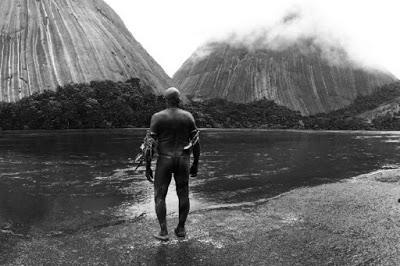
The final decision for the old Karamkate comes from his environment
and wisdom that he has acquired over time
The third stop in both voyages is where the yakruna flower grows. Karamakate’s reactions are different each time. It is important to note that yakruna is a plant that can heal, symbolic of the independence of the natives. And it grows on rubber trees! But commercial compulsions of the developed world always lead to loss of independence of the natives. A rubber slave pleads for death as the rubber sap pail he had nailed to a rubber tree has been emptied and he will have to face brutal consequences from his masters. It is therefore not surprising that Karamakate’s constant refrain to both explorers is to unburden themselves of their material possessions.
Embrace of the Serpent constantly pits personal material possessions against collective traditional memories. The old Karamakate says, “To become warriors, the cohiuanos must abandon all and go alone to the jungle, guided only by their dreams. In this journey, he has to find out, in solitude and silence, who he really is. He must become a wanderer and dream. Many are lost, and some never return. But those who return they are ready to face what is to come.“ The film is unusual in many respects. In the film nine languages are spoken including Spanish, Portuguese, German, Catalan, Latin and four aboriginal Amazonian languages.
Secondly, women are almost peripheral in the film for reasons bestknown to the filmmkers alone.
Then, the film touches on the resources of the river itself—the fish. Karamakate specifically warns the scientist Koch-Grunberg not to fish during a particular period (possibly its breeding period to preserve its numbers) but the German does not listen and answers, “The river is full of fishes. We cannot possibly end them.” Today, oceans and rivers are rapidly losing the rich fish species andtheir diversity by mindless over-fishing.
Finally, there is the contrast of the messages in dreams presented in Embrace of the Serpent —the anaconda suggests that Karamakate kill the scientist Theo, the jaguar suggest the opposite. The two dreams distil the quandary of the film for the viewer—science vs human wisdom. The final action of old Karamakate before he disappears seems to reconcile the jaguar’s view and the shaman’s accumulated wisdom. The American explorer Schultes is cured of his insomnia, he can dream, and is now a changed human being. In a parallel Kubrick moment, he is at home with butterflies!
P.S. Embrace of the Serpent won the Golden Peacock at the 2015 Indian International Film Festival in Goa; the Art cinema award at the Cannes film festival; the Golden Apricot at the Yerevan film festival (Armenia); the Golden Astor at the Mar del Plata international film festival; and the Alfred P. Sloan prize at the Sundance film festival. The film is in myriad ways superior to the Hungarian film Son of Saul, which won the Best Foreign Film Oscar while Embrace of the Serpent lost to the Hungarian challenge after both were final nominees for the award. All three films Land and Shade (Colombia), The Pearl Button (Chile), and Embrace of the Serpent (all released in 2015) are on the author’s top 10 films list for that year and have been separately reviewed in detail on this blog. Another film Who’s Afraid of Virginia Woolf? (1966) mentioned in the above review is also reviewed in detail earlier on this blog.

